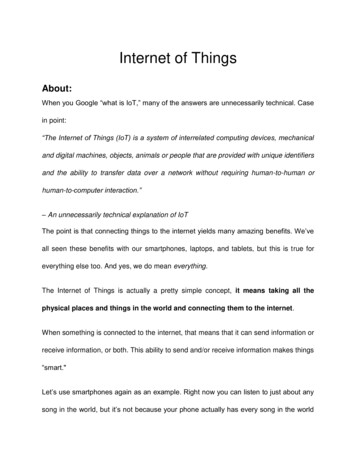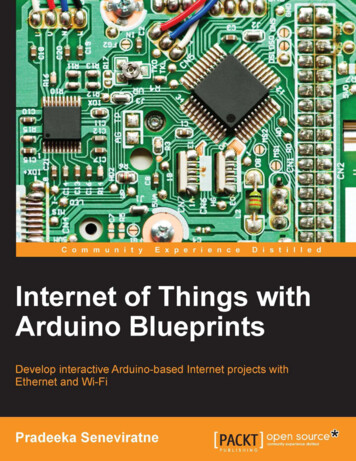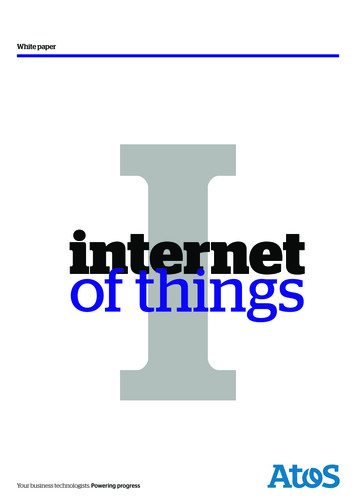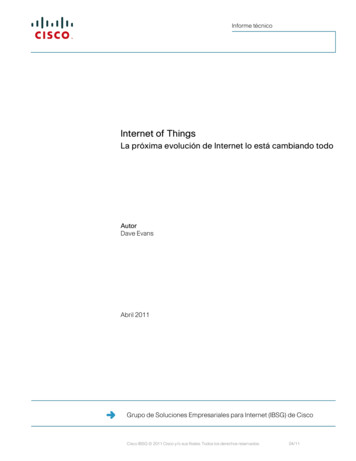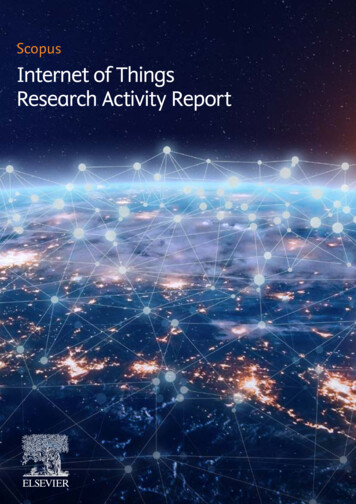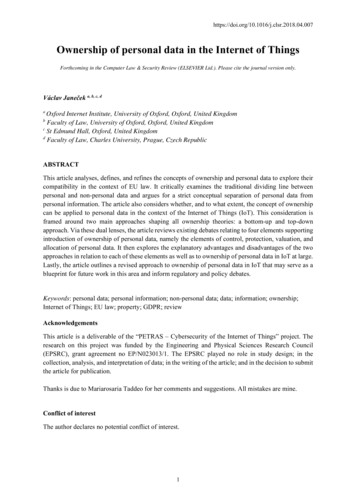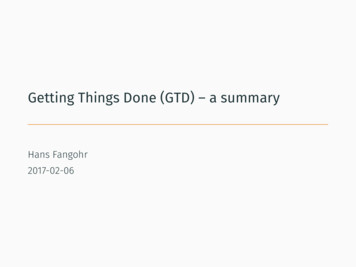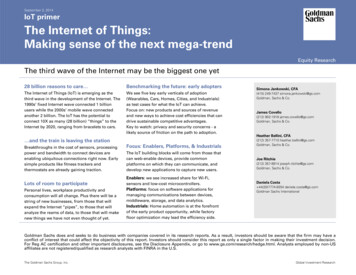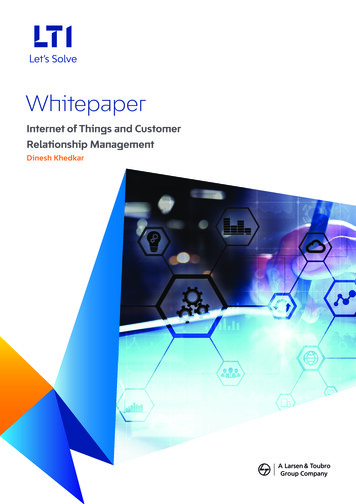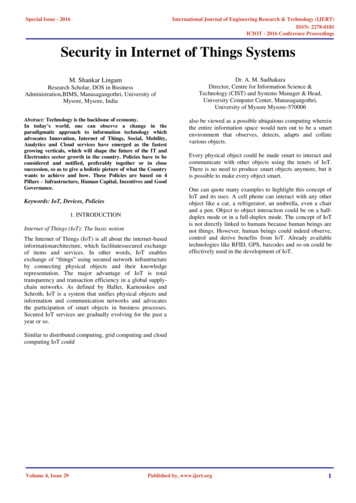
Transcription
Special Issue - 2016International Journal of Engineering Research & Technology (IJERT)ISSN: 2278-0181ICIOT - 2016 Conference ProceedingsSecurity in Internet of Things SystemsM. Shankar LingamResearch Scholar, DOS in BusinessAdministration,BIMS, Manasagangothri, University ofMysore, Mysore, IndiaAbstract: Technology is the backbone of economy.In today’s world, one can observe a change in theparadigmatic approach to information technology whichadvocates Innovation, Internet of Things, Social, Mobility,Analytics and Cloud services have emerged as the fastestgrowing verticals, which will shape the future of the IT andElectronics sector growth in the country. Policies have to beconsidered and notified, preferably together or in closesuccession, so as to give a holistic picture of what the Countrywants to achieve and how. These Policies are based on 4Pillars – Infrastructure, Human Capital, Incentives and GoodGovernance.Keywords: IoT, Devices, Policies1. INTRODUCTIONInternet of Things (IoT): The basic notionThe Internet of Things (IoT) is all about the internet-basedinformationarchitecture, which facilitatessecured exchangeof items and services. In other words, IoT enablesexchange of “things” using secured network infrastructureby connecting physical objects and their knowledgerepresentation. The major advantage of IoT is totaltransparency and transaction efficiency in a global supplychain networks. As defined by Haller, Karnouskos andSchroth, IoT is a system that unifies physical objects andinformation and communication networks and advocatesthe participation of smart objects in business processes.Secured IoT services are gradually evolving for the past ayear or so.Dr. A. M. SudhakaraDirector, Centre for Information Science &Technology (CIST) and Systems Manager & Head,University Computer Center, Manasagangothri,University of Mysore Mysore-570006also be viewed as a possible ubiquitous computing whereinthe entire information space would turn out to be a smartenvironment that observes, detects, adapts and collatevarious objects.Every physical object could be made smart to interact andcommunicate with other objects using the tenets of IoT.There is no need to produce smart objects anymore, but itis possible to make every object smart.One can quote many examples to highlight this concept ofIoT and its uses. A cell phone can interact with any otherobject like a car, a refrigerator, an umbrella, even a chairand a pen. Object to object interaction could be on a halfduplex mode or in a full-duplex mode. The concept of IoTis not directly linked to humans because human beings arenot things. However, human beings could indeed observe,control and derive benefits from IoT. Already availabletechnologies like RFID, GPS, barcodes and so on could beeffectively used in the development of IoT.Similar to distributed computing, grid computing and cloudcomputing IoT couldVolume 4, Issue 29Published by, www.ijert.org1
Special Issue - 2016International Journal of Engineering Research & Technology (IJERT)ISSN: 2278-0181ICIOT - 2016 Conference Proceedings3.Data transmission and decision making usingexpert systemsBlock Diagram of IOTUnder the smart city plan of the Government of India, onecan visualize the constructive use of IoT almost in everywalk of life. Pentagram Research Centre Private Limited, aHyderabad based company along with the help of AvatarMedVision US LLC, NC, a US based company haspropose very recently three initiatives namely Digital FoodInitiative, Digital Health Initiative and Digital SecurityInitiative which would work on certain advanced tenets ofIoT (Ref: www.pentagramresearch.com). These threeinitiatives are framed on certain key aspects of smart cities,to be precise, smart country. Some of them are listedbelow.Many countries(Korea, Denmark, Switzerland andUSA) have already taken initiative to implement IoTenabled infrastructure and services. The steps to betaken for the implementation of IoT are outlined inthe following.1.Investment in the fundamental R&D plays asignificant role in this context.2.Manufacturing of sensors for various datacollection is of paramount importance.3.Multi-sensor fusion techniques have to beseriously looked into1.IoT enabled corporate farming2.IoT enabled transportation of things and people4.Formatting of raw data using big data analyticsmethods are to be studied.3.IoT enabled Farm-To-Home (FTH) distributionsystem5.Machine learning techniques have to bedeveloped for decision making purposes.6.Training of human resource in this area is to beviewed seriously.7.Policy making in government and privatesectors is important in integrating networks.8.A commercial outlook has to be given to theentire initiative for its own survival.4.IoT enabled power distribution system5.6.7.IoT enabled health careIoT enabled security measuresIoT enabled governance2. Implementation of IoTInternet of Things (IoT) is implemented in three stages1.Implant of suitable sensors on things andallocation of addresses for them2.Software for sensor data collection andconsolidationVolume 4, Issue 293. Applications of IoT and ChallengesSome of the applications of IoT are briefly described in thefollowing:Published by, www.ijert.org2
Special Issue - 2016International Journal of Engineering Research & Technology (IJERT)ISSN: 2278-0181ICIOT - 2016 Conference ProceedingsWearable Technology & Personalized ealthcareWearable technology that can collect data, from monitoringphysical activity, and give real-time responses is the futureof personalized healthcare. Wearable devices can readtemperatures, heart-rate, test blood and monitor movementdisorders, and even release medication.Within five years, biometric information pertaining tohuman beings would be available in the network so thatdevices and various physical objects would warn andadvise human beings for corrective measures based onsituation related biometric information.devices and programs, will be beneficial not only toindividuals for saving money but could also have anenvironmental impact in reducing energy use andultimately climate change. A smart lock does not require awireless connection, and users will still be able to use theirlow-tech keys. A signal from a smartphone app would openthe door. Homeowners can send these digital keys tofriends and relatives through the app, and delete them asand when required.Security and Privacy ChallengesMost countries have no laws that specifically mention IoTdevices, so general privacy laws -- many of which went onthe books before anyone had heard of the term 'IoT' -apply when a company wants to collect data from users.These privacy laws vary from country to country, whichcan be a challenge. For example, U.S.-based companiesused to be able to easily collect data from users in the EU,where data privacy laws are stricter, if they were certifiedunder a program called Safe Harbor. But late last year, theEU declared Safe Harbor invalid. So, said Kate Lucente, aUS attorney who works with data privacy issues,"companies have had to scramble to put some backupmechanism in place to make the data transfers legal."The Connected HomeHome automation is a decade old paradigm which will playa significant role in connecting all homes in a city and allcities in a country. Based on the current trend, users willsoon be able to control all home electronics with just theirphone. Studies show people are now using technologydaily for longer periods than they spend sleeping, as theability to multi-task activities easily with smart phones andtablets increases. This level of remote control and access inthe palm of your hand allows users to conserve energy intheir home, even when they are not there. The ease ofdoing this with a simple interface, connecting multipleAs the changeover from closed networks to open enterprisenetworks is rapidly advancing, and the use of smart devicesis surging, many fears have been raised for the security ofdata. As the reliance on IoT technologies becomes morewidespread, and our dependence on interconnected devicesgrows, how will we effectively monitor and protectpersonal information and public safety?The prime objective of IoT is to develop an autonomousworld order in which humaninterference would be reduced to a large extent.Devices and things could be smart, possibly smarterthan human beings but they are not bound byemotions. Alternatively, human beings functionmostly on emotions and hence any system in whichhuman beings play a role is susceptible for corruptionand misuse. This amounts to saying that anyautonomous system with human beings as a part,poses threat to the integrity of the system. So, thebiggest challenge in IoT based system is securitybreach that may lead to chaos and catastrophe.SMART CITIESA smart city is an urban development vision tointegrate multiple information and communicationtechnology (ICT) solutions in a secure fashion tomanage a city‟s assets– the city‟s assets include, but not limited to, localdepartments information systems, schools, libraries,transportation systems, hospitals, power plants, , and other community services. The goalof building a smart city is to improve quality of lifeVolume 4, Issue 29Published by, www.ijert.org3
Special Issue - 2016International Journal of Engineering Research & Technology (IJERT)ISSN: 2278-0181ICIOT - 2016 Conference Proceedingsby using technology to improve the efficiency ofservices and meet residents‟ needs. ICT allows cityofficials to interact directly with the community andthe city infrastructure and to monitor what ishappening in the city, how the city is evolving, andhow to enable a better quality of life. Through the useof sensors integrated with real-time monitoringsystems, data are collected from citizens and devices then processed and analyzed. The information andknowledge gathered are keys to tackling inefficiency.Here, then, are the top 10 smart cities on the w YorkLondonTokyoBerlinCopenhagenHong KongBarcelonaThe Indian Government's plan of developing 100 smartcities in the country, for which Rs. 7,060 crores has beenallocated in the current budget could lead to a massive andquick expansion of IoT in the country. Also, the launch ofthe Digital India Program of the Government, which aimsat„transforming India into digital empowered society andknowledge economy‟ will provide the required impetus fordevelopment of the IoT industry in the country. Thevarious initiatives proposed to be taken under the SmartCity concept and the Digital India Program to setup DigitalInfrastructure in the country would help boost the IoTindustry. IoT will be critical in making these cities smarter.More than fifty per cent of the world‟s populationcurrently lives in cities and the need to make future citiesmore intelligent and connected has never been greater.How can future cities be better designed to benefithealthcare, education, transport and energy needs? – is afundamental question.Future smart cities would turn out to be „flexible‟when natural and environmental situations are also takeninto account while designing IoT enabled smart cities. Adecision made for the dynamics of a smart city in aparticular season need not be the same for another season.Moreover, an expert system based automatic control overthe dynamics of future smart cities is a white space forresearchers and city planners.Emerging Trends & Opportunities in the IoTAlbeit the fact that work is in progress pertaining to sensordevelopment and big data analytics, it is far more importantthat fundamental research is initiated in areas likeenvironmental engineering, prediction of natural calamitiesin disaster prone areas and post calamity damage control.Volume 4, Issue 29Manufacturing will become more efficient with bettersupply chain management; healthcare will be impacted byincreased patient surveillance; agriculture will be enhancedby monitoring crops and controlling growing conditions;our environmental data will be captured and controlled todecrease air pollution; and water leakages will be detectedusing sensor devices, to name a few.Security in the current Internet of Things is not as good atit ought to be. This thesis shows some glaring flaws inexisting products, which is often created because ofoversight from the developers, as the constraints existing inIoT requires a more thorough thought-process than isnormal in desktop computing. Due to limited power,bandwidth and processing power, everything needs to getstripped down to the bare minimum, while still maintaininggood security properties.SummarySecurity is an oversight in many projects. Using examplesfrom previous research, and conducting unique analysis onexisting products, it is shown that many developers more orless ignores everything related to security (BMW,HomeEasy, Sonos), or creates their own cryptographicalgorithms with clear flaws (Eye-Fi, OSGP smartgrid). Toensure that the future of IoT is secure, this thesis aims tomake developers think about the limitations that exists, andprovide solutions to the problems that will occurwhen designing a device for the Internet of Things.Securing the Internet of Things is important to consumers.Through previous research it is shown exactly howdevastating not focusing on the security of IoT devices canbe, with the majority of consumers (62%) “feeling completely violated and extremely angry to thepoint where I would take action.”. Close to half (48%) ofall consumers would hold the manufacturer responsible if aflaw was to be found in the system, showing the obviouseconomical risks taken by not securing a device properly.Some of the topics of challenges presented are common ininformation security, but poses new challenges because ofthe unique constraints. Securing an IT system requiresconfidentiality, integrity, and authorization. Where thisusually is handled by libraries like OpenSSL and usingTLS into desktop computers, deciding on an encryption,authentication and signature algorithm is not as easy ascalling a different method. The limited power, bandwidthand processing capabilities will require a thorough thoughtprocess to decide how to both efficiently, and effectivelysecure a device.The other challenges are more specific to the Internet ofThings. In regular desktop computing, an advanced userinterface is usually available, and physical loss of a deviceduring use is relatively uncommon. IoT devices will on theother hand usually have a really limited user interfaces, andwill often be placed in exposed areas and used in situationswith high physical stress.Security should be a consideration through the wholeproject. Long before the first prototype PCB-design is sentPublished by, www.ijert.org4
Special Issue - 2016International Journal of Engineering Research & Technology (IJERT)ISSN: 2278-0181ICIOT - 2016 Conference Proceedingsto the factory, key decisions on security should have beendecided. These include how keys should be distributed toeach device, if hardware-acceleration should be used, howupdates can be handled, if A public key infrastructure is aviable solution for the device, what type of cryptographicalgorithms should be used, etc.Future WorkThe Internet of Things is a relatively new concept interms of optimized protocols and security, and thusthere is a lot of work for the future. The most pressingissue is simplifying the use of security in IoT fordevelopers without thorough knowledge of ITsecurity. Designing and implementing security inprotocols that is simple for developers to use is a mustfor the future of IoT. Speed and cryptographicstrength is especially important in the Internet ofThings.As devices in the Internet of Things are constraineddevices, efficient implementations of cryptographicalgorithms is especially important to keep thecryptographic strength at an acceptable level.REFERENCES:[1] Sophie Curtis, Director of Marketing at RE WORK[2] e-internet-of-things/wr security-in-the-internet-ofthings.pdf.[3] Draft Policy on Internet of Things, Department ofElectronics & Information Technology (DeitY),Ministry of Communication and InformationTechnology, Government of India[4] sa Tolentino Mar 21, 2014 [5] ngs-growth-developing-countries/[6] ZDNet Korea (zdnet.co.kr)[7] www.aponline.gov.in/apportal/Downloads/2016ITCM S3.pdf[8] Rolf H. Weber, Romana Weber - Internet ofThings.pdf by Springer Publications Security inInternet of Things Systems by Christian Dancke Tuen,Norwegian University of Science and Technology.[9] The Internet of Things: An Overview by Karen Rose,Scott Eldridge, Lyman ChapinThe Internet of Things is an ever-changing area thatwill continue to change in the future. While therecommendations in this thesis are made withassumptions for the future of IoT, and encompassingmany different solutions, one will have to re-examinethe recommendations with large changes in themarket. But as many cryptographic properties willalways be existing and important, most of therecommendations will be the same for all foreseeablefuture.4. CONCLUSIONInternet of Things (IoT) is the future of the world order andwestern countries have already initiated various plans andprograms in this regard. As usual India is lagging behindthem and now is the time for the country to start thinkingin this direction.This is an act of togetherness and integrity and the centraland state governments should take note of this and provideplans and facilities to various governmental and privateindustries. Common man should also be educatedaccordingly.ACKNOWLEDGEMENTThe authors acknowledge support extended by My GuideDr. A. M. Sudhakara, Director, CIST, University ofMysore, Mysore andMesser‟ sPentagramResearch CentrePrivate Limited, Hyderabad for their extensive technicalsupport in making this paper worth presenting as acontributed paper.Volume 4, Issue 29Published by, www.ijert.org5
Security in Internet of Things Systems M. Shankar Lingam Research Scholar, DOS in Business Administration,BIMS, Manasagangothri, University of Mysore, Mysore, India Abstract: Technology is the backbone of economy. In today's world, one can observe a change in the paradigmatic approach to information technology which
